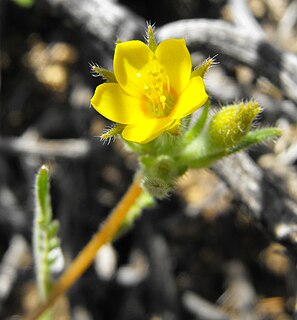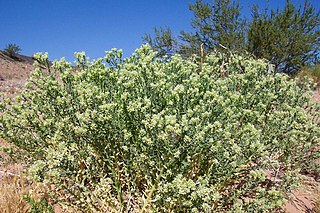
The flowering plants, also known as Angiospermae, or Magnoliophyta, are the most diverse group of land plants, with 64 orders, 416 families, approximately 13,000 known genera and 300,000 known species. Like gymnosperms, angiosperms are seed-producing plants. They are distinguished from gymnosperms by characteristics including flowers, endosperm within their seeds, and the production of fruits that contain the seeds. Etymologically, angiosperm means a plant that produces seeds within an enclosure; in other words, a fruiting plant. The term comes from the Greek words angeion and sperma ("seed").

The Cornales are an order of flowering plants, early diverging among the asterids, containing about 600 species. Plants within the Cornales usually have four-parted flowers, drupaceous fruits, and inferior to half-inferior gynoecia topped with disc-shaped nectaries.

Silene is a genus of flowering plants in the family Caryophyllaceae. Containing nearly 900 species, it is the largest genus in the family. Common names include campion and catchfly. Many Silene species are widely distributed, particularly in the northern hemisphere.

A fruit tree is a tree which bears fruit that is consumed or used by humans and some animals — all trees that are flowering plants produce fruit, which are the ripened ovaries of flowers containing one or more seeds. In horticultural usage, the term "fruit tree" is limited to those that provide fruit for human food. Types of fruits are described and defined elsewhere, but would include "fruit" in a culinary sense, as well as some nut-bearing trees, such as walnuts.
The Cronquist system is a taxonomic classification system of flowering plants. It was developed by Arthur Cronquist in a series of monographs and texts, including The Evolution and Classification of Flowering Plants and An Integrated System of Classification of Flowering Plants (1981).
Carl August Wilhelm Schwacke (1848–1904) was a German botanist, explorer and naturalist.
Friedrich Georg Hendel was an Austrian high school director and entomologist mainly interested in Diptera. He described very many new species and made important contributions to the higher taxonomy of the Diptera.
Robert Knud Friedrich Pilger was a German botanist, who specialised in the study of conifers.

Loasaceae is a family of 15–20 genera and about 200–260 species of flowering plants in the order Cornales, native to the Americas and Africa. Members of the family include annual, biennial and perennial herbaceous plants, and a few shrubs and small trees.
Heinrich Benno Möschler was a German entomologist specialised in Lepidoptera.
In enzymology, a galactinol-raffinose galactosyltransferase is an enzyme that catalyzes the chemical reaction
Mentzelia affinis is a species of flowering plants in the family Loasaceae known by the common name yellowcomet. It is native to the southern half of California, Arizona, and adjacent sections of Nevada and Baja California, where it is known from scrub, woodland, desert sands, and other habitat types.

Mentzelia albicaulis is a species of flowering plants in the family Loasaceae known by the common names whitestem blazingstar, white-stemmed stickleaf, and small flowered blazing star. It is native to much of western North America, where it grows in mountain, desert, and plateau habitat.

Petalonyx nitidus is a species of flowering plant in the family Loasaceae known by the common name shinyleaf sandpaper plant. It is native to the deserts and desert mountains of the southwestern United States, where it grows in scrub, woodland, and other habitat. It is a clumpy subshrub made up of many rough-haired, erect or spreading stems growing 15 to 45 centimeters long. The leaves are oval, pointed, usually toothed or serrated, and up to 4 centimeters long. The inflorescence at the end of the stem is a crowded raceme of many flowers. The flower appears tubular, its white petals fused near the spreading tips but open lower, the long stamens extending well beyond the corolla, and unusual in that they emerge from outside the corolla.

Petalonyx thurberi is a species of flowering plant in the family Loasaceae known by the common names Thurber's sandpaper plant and common sandpaper plant. It is native to the deserts of the southwestern United States and northwestern Mexico, where it grows in sandy and scrubby habitat. It is a rounded or spreading, clumpy subshrub made up of many rough-haired stems approaching one meter in maximum height. The stems are lined with clasping leaves varying in shape from lance-shaped to triangular to oval and sometimes toothed. The inflorescence at the end of the stem is a small, crowded raceme of several flowers. The white flower appears tubular, its petals fused near the spreading tips but open lower, the stamens emerging from outside the corolla.

Hermann Merxmüller was a German botanist and taxonomist.

Bidens beckii, commonly called Beck's water-marigold or simply water marigold is a species of flowering plant in the daisy family. It is native to Canada and the northern United States.

Allioideae is a subfamily of monocot flowering plants in the family Amaryllidaceae, order Asparagales. It was formerly treated as a separate family, Alliaceae. The subfamily name is derived from the generic name of the type genus, Allium. It is composed of about 18 genera.

Gronovia is a genus of flowering plants in the family Loasaceae, native to Mexico, Central America and northwest South America. They are annual climbing herbs with irritating stinging hairs.











